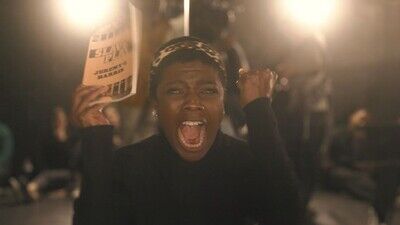Within the first few minutes, he bombards the audience with review after review from critics and influencers alike. Using ripped news coverage, TikTok reels, and faceless criticisms, Harris and his editors, Peter Ohs and Teki Cruickshank, emphasize the play’s reputation before we’re even five minutes into the film, as if to say, “This is what the world is saying; what do you think?” The approach suggests that Harris is inviting the audience into the conversation. Art is subjective, and “Slave Play. Not A Movie. A Play.” is no exception.
Like Orson Welles’ 1973 film “F is for Fake,” Harris doesn’t connect scenes; he connects thoughts. Harris intercuts footage from various rehearsals with different actors and the theatrical productions, often showing similar scenes side by side. Like a casting director, we see how other actors approach the same scene. Their line delivery, physical tics, and interactions with their co-stars bring a unique viewing experience to the audience. It feels like we’re watching the play be written and dissected over and over again.
The tactic gives the impression that we’re inside Harris’s mind as he watches and rewatches the film in the edit. In fact, Harris states this very sentiment as we observe him and Peter Ohs edit the film within the film. He remarks on how cinema differs from theater because there are so many choices, so many scenes, and so many performances. Despite its racial undertones, “Slave Play. Not A Movie. A Play.” is as unserious as the theatrical Broadway production. Harris is in his element, captivating the audience with humorous delight and a flair for style. Both metaphorically and literally, as Harris stands out with his wardrobe compared to his supporting cast. Without uttering any exposition, it is clear Harris is our main character. We observe him; we notice how he walks and talks. But more importantly, we see how he thinks.

